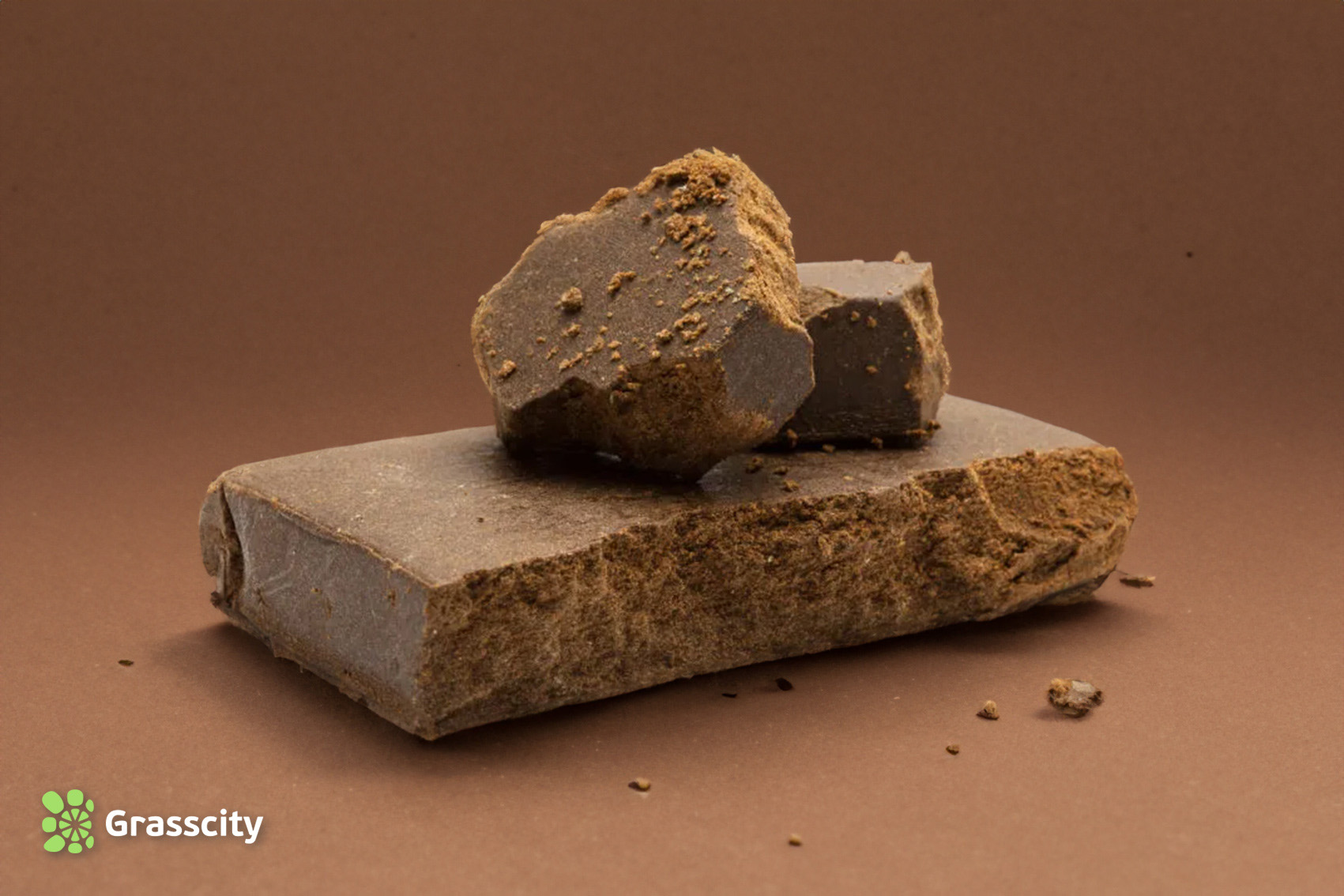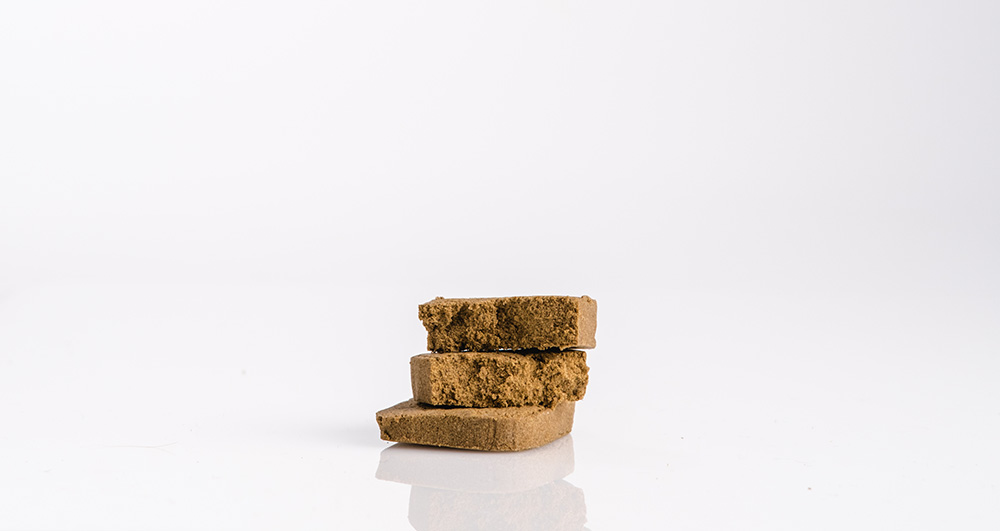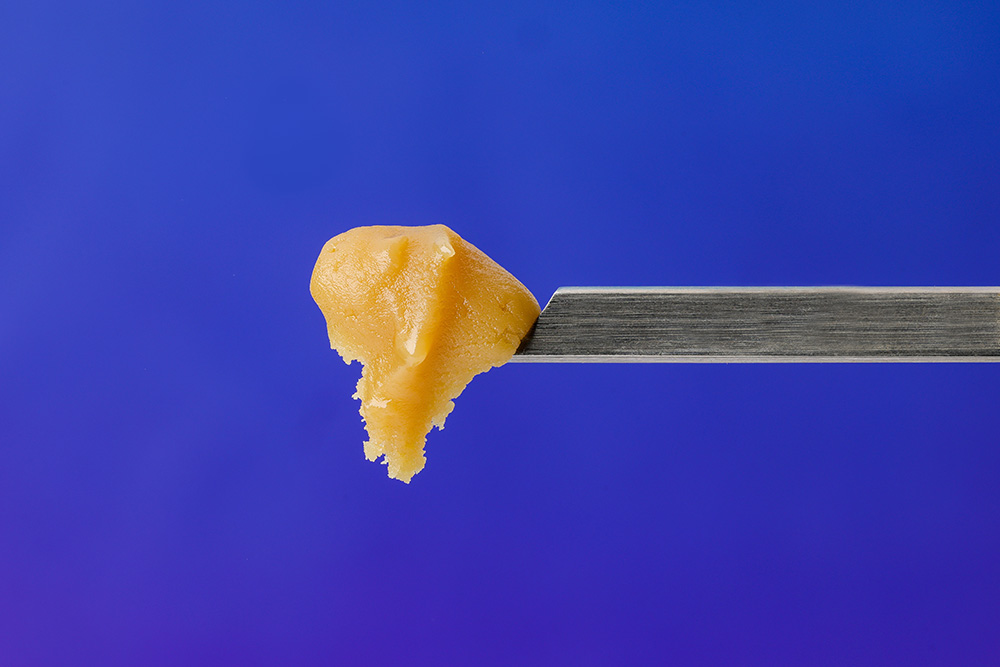
Hash has held its ground for thousands of years as a cornerstone of cannabis culture. While today's market may be flooded with newer, purer concentrates like shatter and live resin, hash's rich history and unique allure are undeniable.
Come along with us on a journey to uncover the mystique of hash. We'll explore its origins, the techniques used to create it, and the various types that have emerged over the years. Whether you're a seasoned enthusiast or a curious newcomer, let's learn more about hash together.
What is Hash?
Hash, often called hashish, is a potent cannabis concentrate derived from trichomes—the sparkling resin glands adorning cannabis buds.
These THC-rich trichomes make hash a sought-after form of cannabis due to its heightened potency. Typically, hash is a malleable "ball" or "brick" with a texture ranging from soft and pliable to more brittle forms reminiscent of kief.
Kief is essentially unpressed hash, holding onto its powdery consistency until compacted. Most people smoke hash using a bong, but the versatility of it allows for dabbing or vaporizing, provided its purity is high enough. Its concentrated nature makes it a favored ingredient in edibles to infuse dishes with a potent cannabinoid kick.
The History of Hash
The history of hash can be traced back to Persia and Central Asia. As trade routes expanded, hashish spread along the Silk Road, eventually reaching the Middle East. During that era, it was commonly used as incense and was considered a valuable commodity.
The earliest method of producing hashish was to gently rub growing cannabis plants together to capture the resinous trichomes, which were then compressed to form hash. By the 12th and 13th centuries, references to hashish began to appear, marking it as one of the oldest forms of cannabis concentrates.
Over time, people developed more sophisticated techniques, like using woven sieves to extract trichomes from dried and cured cannabis, resulting in the hash we know today.
Hash has made a comeback in recent years, thanks in part to the increasing legality of cannabis. It remains a popular choice in the cannabis market thanks to its distinctive preparation methods and concentration of active ingredients. It's a versatile option for both recreational and medicinal purposes.
Types of Hash
Hash has been a staple in cannabis culture for centuries, offering a variety of types that cater to different preferences and needs.
- Dry-Sieve or Dry-Sift Hash: This type of hash is made by sieving dried cannabis buds through fine-mesh screens. The trichomes are separated into a fine powder known as kief and then pressed into blocks.
- Handmade Hash: This hash is made by rubbing live cannabis buds between the hands. The trichomes form a thick, dark resin that is then shaped into balls or sticks. This form of hash is deeply rooted in the traditions of the Indian subcontinent.
- Bubble Hash: Also called Water Hash or Ice-O-Lator hash, this type is made by mixing frozen cannabis buds with water and ice. The mixture is agitated to separate the trichomes, which are sifted through mesh sieves.
- Rosin: Rosin is made by pressing dried cannabis buds with high pressure and heat. The outcome is a clear, golden extract that is free of contaminants and rich in flavor and potency.
- Solvent Hash: This includes modern concentrates like wax, shatter, budder, and live resin. These are made using solvents like butane, propane, or CO2 and are known for their high levels of THC and other cannabinoids.

How To Make Hash
Several methods are used to make hash, with some being more sophisticated than others. Here are some of the most common methods.
Handmade Method
The handmade method is a classic. You just separate trichomes from your cannabis buds using your hands. Press the collected resin into a block, and voila, you've got hashish. This method, known as "charas" in India, yields a concentrate with higher levels of THC, offering a unique experience compared to other cannabis products.
Shoe Method
All you need for the shoe method is some quality kief and shoes. Put your kief in a plastic bag and seal it tightly. Poke a tiny hole in the bag, put it into the heel of your shoe, and walk around.
The pressure and friction will naturally compress the kief into hash at the bottom of the bag. After a good walk, collect your hash and enjoy!
This method is perfect if you want to make hash and get your steps in for the day.
Dry-Sift Method
The dry-sift method is simple and effective. All you need is cannabis and micron screens. Start by brushing your plant material back and forth on the first, largest screen. This separates the trichomes from the plant. Then, move the sifted material to a second, finer screen to purify it. The result is a high-quality dry sift rich in cannabinoids and terpenes.
Bubble Hash Method
Bubble hash is made using ice, water, and silk-screen filters. You start by lining a bucket with micron filters and layering ice and cannabis buds. Fill the bucket with water and stir gently. As the ice melts, trichomes separate and fall through the filters. It's a traditional yet effective method that has stood the test of time.
Rosin Hash
Making Rosin Hash is a solvent-free method that's gained popularity recently. Trichomes are extracted from the plant material using heat and pressure, resulting in a sticky resin rich in cannabinoids and THC. It's a favorite for dabbing and offers a cleaner, purer concentration of THC. This technique is a go-to for those seeking a pure hash without solvents.
Solvent Hash
Solvent hash is a potent form of cannabis concentrate made using solvents like butane or ethanol to extract THC, cannabinoids, and terpenes from the plant material. The process involves passing the solvent through cannabis to collect the sticky resin glands or trichomes. Once the solvent evaporates, you're left with a high concentration of THC product perfect for dabbing or using in a vaporizer.

Benefits of Hash
- Potency: One of the standout benefits of hash is its potency. Thanks to its trichome-rich composition, hash contains higher THC concentrations than traditional cannabis buds. This makes for a more intense and longer-lasting high, appealing to those looking for a stronger effect.
- Purity: Hash is often considered a purer form of cannabis. Unlike traditional buds, which contain a mix of plant material, hash is more concentrated and contains less organic matter. This results in a smoother, cleaner smoke or vapor, which many users find more pleasant.
- Versatility: The versatility of hash is genuinely remarkable. Its play-dough-like consistency allows you to manipulate it in various ways. Whether you want to crumble it over a bowl, roll it into a joint, or even use it for dabbing, hash offers a range of options for consumption.
- Easy to Make: Hash is surprisingly easy to make at home, adding to its appeal. You don't need a chemistry lab or specialized equipment to produce your own hash. Simple methods like hand-made or using a pollen press can yield excellent results.
How to Smoke Hash
Smoking hash offers a variety of methods to suit your needs. Here's a rundown:
Add to Bowl Packs
Elevate your bong or bowl experience by sprinkling hash on top of your ground flower. This blend enriches the cannabinoids and THC levels, making for a more potent sesh.
Add to Joints or Blunts
Are you rolling a joint or blunt? Mix in some hash for an added kick. The combination enhances the effects of hashish and the active ingredient, delta-9-tetrahydrocannabinol, for a well-rounded experience.
Straight Up
For the purists, smoking hash straight-up delivers a highly potent toking experience. This method is best for those who appreciate the concentrated form of cannabis and higher concentrations of THC.
Vaporized or Dabbed
If you're into dabbing or using a vaporizer, opt for purer forms of hash, like shatter. These solvent products are ideal for vaporizing, but be cautious—organic byproducts can gunk up your dab rig or vaporizer, affecting the quality of your session.
Hot Knife Method
This old-school technique involves pressing the hash between two hot knives to vaporize it. While it carries a level of novelty, it's not the most efficient or safest method and generally isn't recommended.
Hashing it All Together
Hash and its many forms have become exceptionally popular as cannabis use continues to rise worldwide. With its many different forms and methods of consumption, there’s no question that casual and daily cannabis users alike will continue to hold a special place in their hearts for this versatile cannabis concentrate.
Hash Frequently Asked Questions (FAQs)
What's the Difference Between Hash and Bud?
Hash and bud differ significantly in their composition and potency. Bud refers to the dried flowers of the Cannabis sativa plant. Hash is a concentrated form of cannabis made from the sticky resin glands or trichomes.
Is Hash Legal?
The legality of hash varies by jurisdiction and is often tied to the laws governing cannabis use. Always check your local laws and treatment options if you're considering using hash or marijuana products.
How Strong is Hash?
Hash is generally stronger than bud due to its higher concentration of THC, or delta-9-tetrahydrocannabinol. The levels of THC can vary widely depending on the method of production and the quality of the plant material used.
How is Hash Consumed?
Hash can be consumed in various ways, including smoking, dabbing, or vaping. Traditional methods include using a water pipe or bong, while more modern approaches involve vaporizers.
How Should Hash Be Stored?
To maintain its quality, hash should be stored in a cool, dry place away from direct sunlight. Airtight containers are ideal for long-term storage.
What are the Effects of Smoking Hash?
Smoking hash can produce both short-term and long-term effects. You may experience heightened senses, altered problem-solving abilities, and a sense of euphoria. Everyone's experience will be different.
